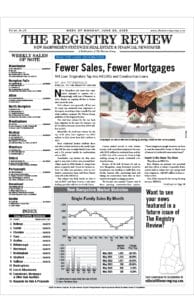Jason Richardson leads the newly created property management division at Foxfield. The Boston-based developer has 7 million square feet of real estate assets under management or development along the East Coast, including properties in Nashua, Salem and Londonderry. Foxfield placed 17 properties under the new Foxfield Management umbrella in May, comprising more than 2.1 million square feet of office, warehouse and industrial flex space. Richardson previously oversaw a 10-million-square-foot property management portfolio in New England for brokerage Newmark.
Q: What are the advantages for Foxfield of bringing the property management services in-house?
A: The advantage for the team is to ensure that the operation aligns with the ownership goals on day-to-day execution. The Foxfield team has been thinking about this for a few years, and decided to finally pull the trigger. At the end of the day, the two goals were to improve connections with the tenants and vendors, and better operational control which will turn into better value for the investors and stakeholders.
Q: Will Foxfield be pursuing property management for outside clients?
A: It is primarily going to be in-house assets, but we’re definitely open to it. My past experience was all third-party at Newmark, Transwestern and CBRE, so it’s a service offering that I’m very familiar with. The focus is transitioning our in-house portfolio, but we’re definitely open to that for the right clients and partners.
Q: What are the biggest changes in property management during your career?
A: The big difference from when I first started in the industry is there is a lot of different technology: AI, work order systems, energy management systems, which are all great. Nowadays, what is really important is finding the right blend, but not forgetting these are still tangible assets. This is the real estate business, but it’s [also] the people business. We have to ensure we are not relying 100 percent on technology, still getting out to properties and meeting tenants and vendors, being visible and vigilant. Nowadays, especially in the post-COVID world, amenities are top of mind for tenants, and quality of service too.
Q: How is the role of property manager in recent years changing amid the transition to decarbonized building systems?
A: It’s critical. It goes back to being on-site and knowing your property, energy management systems, building management systems. That’s where you really need to know your building and how it operates, and ensure you’re maintaining operational efficiency as best as you can from a sustainability standpoint for utility costs. But you can’t sacrifice tenant comfort and tenant experience.
Q: Are more developers getting into property management to diversify their revenue streams amid the downturn in transaction and development activity?
A: The last five years you have seen groups with some similar initiatives, and it could be that. It’s more focused on control of tenant experience, improved operational efficiencies. It definitely has been a trend locally for the last few years.
Q: What is Foxfield’s growth strategy?
A: The main focus of prior years has been New England-based, and that’s still the core business for Foxfield. But the last few years, we’ve been expanding the footprint down the East Coast to Pennsylvania and Georgia. We own industrial, flex industrial, retail and some office space, and probably a continued focus on industrial. They are open to all asset types. Locally for our industrial assets, we are in a very good situation. We have a high lease percentage with very low tenant roll for the next 12 months. That speaks to the demand in the market, which is a little different than some of the other asset types. So we’re very fortunate. It speaks to the relationships that Foxfield has made with the tenants and meeting their needs.
Q: What are the keys to maintaining a good relationship with tenants?
A: The first thing is being on-site and being reachable, having established lines of communication. For our property management standpoint, you have to execute and deliver on what you communicate and promise. With our group, that’s what the primary focus is: establishing those strong lines of communication and, more importantly, executing.
Q: How is the increasing prevalence of extreme weather affect disaster preparedness plans?
A: You’re never really planning for today or this week. You’re planning for the worst-case scenario. I really enjoy that part of it. One aspect for our team is being prepared and supporting the managers so they have the tools ready: having response plans and procedures in place so if a situation arises, the management team knows who to contact. We have a handful of portfolio vendors who are engaged now who will be our service partners in the event of emergencies and disasters as they arise.


